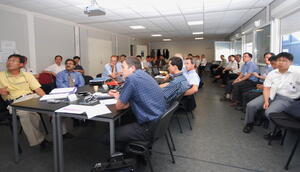Don't waste it—ITER's radwaste management
This week, more than 50 experts from India, Korea, France, Germany, Italy, UK and the US together with representatives from the ITER Organization and Domestic Agencies in Europe, Japan and the US participated in a workshop on the ITER radwaste treatment and storage systems. The workshop was a peer review of the strategy and designs of the proposed radioactive waste (radwaste) treatment and storage systems— an important step before moving forward with design activity.
The radwaste generated by in-vessel component replacements during ITER operation will be treated and stored in the Hot Cell building basement. The liquid and solid radwaste generated by the fusion process and housekeeping operations on the ITER machine will be managed in the Radwaste Building in a safe manner based on international and French guidelines.
The strategy and policy of the ITER Organization for the treatment of radwaste is to keep its production to a minimum, and to properly and safely manage all relating issues in order to protect the worker and the public. To fulfill this fundamental requirement, the design of the ITER radwaste treatment and storage systems clearly defines the process, required equipment and its capacity, and the optimized arrangement of the equipment and general layouts.
In this week's workshop, a consensus on the current designs and strategy of the ITER radwaste management systems was reached with recommendations for the follow-up design activities. The ITER radwaste management system designs take advantage of the accumulated experience and expertise from nuclear practices and proven state-of-the-art technologies.


